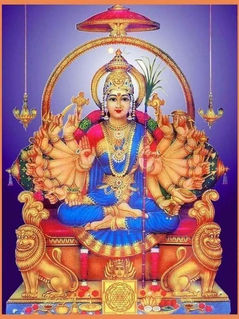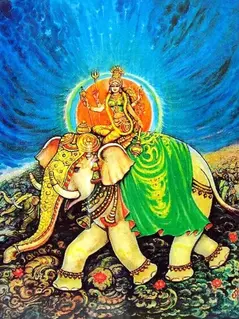
Goddesses in Shri Vidya
The Sri Vidya sect of Shaktism is a revered and complex spiritual tradition that emphasizes the devotion of Lalita Tripurasundari as the supreme being. The practice of worshipping the goddess through a specific yantra known as the Sri Chakra, accompanied by mantras and rituals, is primary to this belief system. Sri Vidya is well-known for its complicated philosophy and meditative techniques, which are similar to Kashmir Shaivism.
Lalita Tripurasundari
Lalita Tripurasundari, also known as Sodashi, Rajarajeswari, Kamakshi, and Lalita, is a supreme manifestation of Shakti. Her name means “who is beautiful in the three states of consciousness”. As Sodashi, she is depicted as a 16-year-old girl in a gold or red complexion, three eyes, and a calm face. She has four hands, holding a goad, a noose, a bow, and an arrow, seated on a lotus that rests on the Shiva laying on a throne. The throne's legs are Brahma, Vishnu, Shiva, and Rudra, making her iconography a powerful depiction of the Supreme goddess. As Lalita Tripurasundari or Rajarajeshwari, she is the primary goddess of the Sri Vidya sect of Shaktisim and manifested the form of Adi Parashakti. She is depicted seated on Shiva, who is laying on a throne. She has a flower and sugarcane replacing the bow and arrow and the other two hands carrying a goad and noose.
Goddesses in Sri Chakra
Shri Chakra is a Hindu yantra (diagram) used in the Shri Vidya school, a tantric sect, to represent the goddess Lalita. It symbolizes the cosmos and the human body or Shiva and Shakti as a combined whole. When represented three-dimensionally, it is called a Meru Chakra. The yantra consists of nine interlocking triangles enclosed in concentric two circles and a central point, Bindu. Each level corresponds to specific forms of Shakti, Mudra, and Yoginis, and is guided by different forms of goddess Laita. These levels (also called Avaranas) from outer to inner, are named as follows:
-
Trailokya Mohana: The outermost three squares are intervened by four recessed openings.
-
Sarvasaa Paripuraka: The outer lotus, consisting of 16 petals.
-
Sarva Samkshobahana: The inner lotus, consisting of 8 petals.
-
Sarva Saubhagyadayaka: The outermost ring of fourteen triangles.
-
Sarvarthasadhaka: The subsequent ring of ten triangles.
-
Sarva Rakshakara: The smaller ring of ten triangles.
-
Sarva Rogahara: The ring of eight triangles.
-
Sarva Siddhiprada: One small triangle at the center.
-
Sarva Anandamaya: The Bindu at the center.
Navavarana Pooja names the following goddesses, also called Khadgamala goddesses, in Sri Chakra:
1. Trailokya Mohana
The goddess guiding this Avarana is Tripura. The Avarana consists of three lines. The outermost line has 10 goddesses known as Siddhi Devis. They are:
1. Anima Sidhyamba
2. Laghima Sidhyamba
3. Mahima Sidhyamba
4. Ishvita Sidhyamba
5. Vasitva Sidhyamba
6. Prakamya Sidhyamba
7. Bhukti Sidhyamba
8. Ichha Sidhyamba
9. Prapti Sidhyamba
10. Sarvakama Sidhyamba
The middle line has eight Matrika goddesses. They are:
1. Brahmi
2. Maheshwari
3. Kumari
4. Vishnavi
5. Varahi
6. Mahendri (Indrani)
7. Chamunda
8. Mahalakshmi
The innermost line has ten Mudra Shaktis personified as goddesses. They are:
1. Sarvasankshobhini Devi
2. Sarvavidravini Devi
3. Sarvakarshini Devi
4. Sarvavashankari Devi
5. Sarvonmadini Devi
6. Sarvamahankusha Devi
7. Sarvakhechari Devi
8. Sarvabeeja Devi
9. Sarvayoni Devi
10.Sarvatrikhanda Devi
2. Sarvasaa Paripuraka
The presiding form of goddess Lalita in this Avarana is Tripureshi. She is depicted carrying a book and a rosary. The sixteen Yoginis residing here are called Gupta Yogini. They are:
-
Kamakarshini
-
Budhyakarshini
-
Ahankarakarshini
-
Shabdakarshini
-
Sparshakarshini
-
Rupakarshini
-
Rasakarshini
-
Gandhakarshini
9. Chittakarshini
10. Dhyryakarshini
11. Smrutyakarshini
12. Namakarshini
13. Beejakarshini
14. Atmakarshini
15. Amrutakarshini
16. Sharirakarshini
3.Sarva Samkshobahana
The presiding form of goddess Lalita in this Avarana is Tripura Sundari. She is depicted smiling and showing the Abhaya and Varada mudras. The eight Yoginis residing here are called Guptatara Yogini. They are:
1. Anangakusuma
2. Anangamekhala
3. Anangamadana
4. Anangamadanatura
5. Anangarekha
6. Anangavegini
7. Anangankusha
8. Anangamalini
4. Sarva Saubhagyadayaka
The presiding form of goddess Lalita in this Avarana is Tripura Vasini. She is depicted in a red complexion. The fourteen yoginis residing here are called Sampradaya Yogini. They are:
1. Sarvasmkshobhini
2. Sarvavidravini
3. Sarvakarshini
4. Sarvaahladini
5. Sarvasammohini
6. Sarvasthambhini
7. Sarvajrumbhini
8. Sarvavashankari
9. Sarvaranjani
10. Sarvonmadini
11. Sarvarthasadhika
12. Sarvasampattipurani
13. Sarvamantramayi
14. Sarvadwandwakshayankari
5. Sarvarthasadhaka
The presiding form of goddess Lalita in this Avarana is Tripurasri. She is depicted in a red complexion, holding a noose, goad, skull, and one hand Abhaya mudra. The ten yoginis residing here are called Kulotteerna/ Kula Yogini. They are:
1. Sarva Siddhiprada
2. Sarvasampatprada
3. Sarvapriyankari
4. Sarvamangalakarini
5. Sarvakamaprada
6. Sarvadukhavimochini
7. Sarvamrityuprasamani
8. Sarvavighnanivarini
9. Sarvangasundari
10. Sarvasoubhagyadayini
6. Sarva Rakshakara
The presiding form of goddess Lalita in this Avarana is Tripura Malini. She is depicted in a red complexion, holding a noose, goad, skull, and one hand Abhaya mudra. The ten yoginis residing here are called Nigarbha Yoginis. They are the shakti of the ten vital gires. They are:
1. Sarvagya
2. Sarvashakti
3. Sarvaswaryapradayini
4. Sarvagyanamayi
5. Sarvavyadhinivarini
6. Sarvadharaswarupa
7. Sarvapapahara
8. Sarvanandamayi
9. Sarvarakshaswarupini
10. Sarvepsitaphalaprada
7. Sarva Rogahara
The presiding form of goddess Lalita in this Avarana is Tripura Siddhamba. She is described as the destroyer of poison. The eight devis, also called Rahasaya yoginis, residing here are:
1. Vasini Vagdevi
2. Kameswari Vagdevi
3. Modini Vagdevi
4. Kamala Vagdevi
5. Aruna Vagdevi
6. Jayini Vagdevi
7. Sarveswari Vagdevi
8. Koushini Vagdevi
8. Sarva Siddhiprada
The presiding form of goddess Lalita in this Avarana is Tripuramba. She is depicted in a coppery complexion, holding a rosary and one hand Varada mudra. The three devis, also called Atirahasaya Yoginis, residing here are:
1. Kameshvari: She is a form of Parvati.
2. Vajreshi: She is a form of Lakshmi or Parvati.
3. Bhagamalini: She is a form of Saraswati.
9. Sarva Anandamaya
The presiding form of goddess Lalita in this Avarana is Rajarajeshvari or Mahatripurasundari.
Forms and Incarnations of Tripurasundari
1. Kamakshi: In Kanchipuram Shakti Peetha, Lalita is worshipped in the form of Kamakshi, portrayed with four arms carrying a goad, a noose, a cane, and a bouquet of flowers. (Read: Shakti Peethas)
2. Para Ambika: She is who is the primordial mother of the Universe. She is shown with two hands, carrying a bowl of jewels and a lotus. She is seated on a throne and has one crescent moon on her crown.
3. Purna Shodashi: Also called Mahashodashi, she is considered to be the matured form of the goddess Shodashi and a composite form of Lalita and Kali. Her complexion is greyish red and has four to eight hands carrying a goad, noose, severed head, sacrificial sword, flower arrows and a sugarcane bow, and she shows Abhaya and Varada mudra.
4. Bagala Sundari: She is depicted seated on a lotus, with a golden hue. She is holding two lotus in her upper two hands and lower two hands in abhaya and varada mudra.
5. Sri Shodashi: She is depicted with tweleve hands carring a goad, noose, manuscript, rosary, sugarcane bow, flower arrows, and two lotuses, the remaining two hands and abhaya and varada mudra.
6. Tripura Parameshwari: Also called Ashatadashabhuja Maha Shodashi, is the ultimate form of Lalita and depicted with eighteen hands carrying various attributes. She has a golden complexion and a smiling face and she is seated on a throne.
7. Bala Tripurasundari: She is a tutelary goddess of the Sri Vidya sect and is considered as a younger form of Tripura Sundari or her daughter. In Brahmanda Purana, she is mentioned as a nine-year-old girl who defeated Bhandasura, an asura. She is portrayed seated on a lotus and carrying a rosary and a manuscript in her upper hands and the lower hands in abhaya and varada mudra. Bala Tripurasundari is further depicted in twenty-three forms. They are Bala Vanni, Bala Tripurasundari, Bala Ramma, Bala Gauri, Bala Kumari, Bala Durga, Bala Beejapura Sundari, Bala Mrutha Sanjeevani, Bala Lalitha, Bala Shyamala, Bala Kameshi, Nemili Bala Tripurasundari, Bala Varahi, Bala Bhuvaneshwari, Sri Chaithanya Bala Tripurasundari, Bala Lalitha Tripurasundari, Bala Kameshi, Uchista Bala Trilokyamohana, Damari Bala Tripurasundari, Bala Utklinna, Bala Manonmani, Bala Hedabi and Bala Aghora.
8. Ashwarooda: She is the one who rides a horse. Ashwarooda was created from the noose held by Tripurasundari while fighting Bhandasura, mentioned in Brahmanda Purana. She is depicted riding a horse and has four hands carrying a noose, goad, whip or cane, and rein of a horse.
8. Sampatkari: She was created from the goad held by Tripurasundari to head the elephant forces while fighting Bhandasura. She is depicted riding an elephant and has four hands carrying a noose, goad, mace, and trident.
Goddesses in Pancapancikaa
A Tantric literature series known as "Pancapancikaa" describes five different categories of divinities in five different forms. Among these five categories, there are four different goddesses, along with Lalitambika, as the main figure. They are:
-
Pancha Lakshmi
-
Lakshmi
-
Mahalakshmi
-
Trishakti
-
Sarvasaamrasjya
-
-
Pancha Kōśāmba
-
Paranjyooti
-
Paranishkala
-
Ajapaa
-
Maatrkaa
-
-
Pancha Kalpalata
-
Pancakameshvari
-
Parijateshvari/ Parijata Saraswati
-
Kumari
-
Pancabanesvari
-
-
Pancha Kamadugha
-
Amrtapitheshvari
-
Sudhasuh
-
Amrteshvari
-
Annapurna
-
-
Pancha Ratnamba
-
Siddhalakshmi
-
Raja Matangishvari
-
Bhuvaneshvari
-
Maha Varahi
-
Nitya Devis
The fifteen visible phases of the moon are represented by the Nitya Devis, which are distinct eternities of goddess Lalita Tripurasundari. In Hindu astrology, the moon is regarded as an essential celestial body. It has Sixteen phases, called kalas. 15 of these are visible to us, and the 16th remains hidden from sight. Along with Goddess Tripurasundari, who leads the first Kala named Amrita, which is invisible to most mortals, this group of Fifteen goddesses governs the fifteen visible Kalas. (Read: Nitya Devis)
Saundarya Lahari
Soundarya Lahari, which means ‘Wave of Beauty’, is a composition of one hundred verses written by sage Adi Shankara. The verses are dedicated to goddess Lalita Tripura Sundari and various forms of the Devi. Verses 1–41 discuss the ancient rituals of Tantra, Yantra, and different Mantras, while verses 42–100 mostly focus on the Goddess's appearance. Following is the list of the hundred goddesses mentioned in the Verses:
1. Raja Rajeshwari
2. Mahakali
3. Mahalakshmi
4. Mahasaraswati
5. Anima Siddhi
6. Dasha Mudra
7. Gupta Yogini
8. Gupta Tarayogini
9. Sampradaya Yogini
10. Kulotheerna Yogini
11. Nigarba Yogini
12. Rahasya Yogini
13. Athi Rahasya Yogini
14. Nithyaklinna
15. Kameshi
16. Bhagamalini
17. Berunda
18.Vindhyavasini
19. Maha Vajreshwari
20. Shivadooti
21. Neelapatakini
22.Vijaya
23. Sarvamangala
24. Chitra
25.Tripura Sundari
26.Yoganidra
27. Bhadra Kali
28. Shakini
29. Swadhisthana
30.Lakini Pitastha Kakini
31.Rakini
32.Dakini
33.Jalandhara Pitastha Yakini
34.Brahmi
35.Maheshwari
36.Kaumari
37.Vaishnavi
38.Varahi
39.Chamunda
40.Indrani
41. Chandika
42. Brahmacharini Durga
43. Skanda Durga
44. Samvit Tiripura
45. Navadurga
46. Rudraamsha
47. Pratyangira
48. Shoolini
49. Ugratara
50. Mahishamardini
51.Varuni
52. Aparajita
53. Dandanatha Varahi
54. Suddha Varahi
55. Raja Matangi
56. Mruthasanjeevini
57. Bagala
58. Prashna Sakthi
59. Suddha Vidya
60. Shri Vidya
61.Vanashankari
62. Kama Kaleshwari
63. Chatuh Shashti
64. Sarva Varneshwari
65. Dwadashardha
66.Thiraskarani
67. Indrakshi
68. Chandra Parameshwari 69.Tulasi
70. Gayatri
71. Savitri
72. Nila Saraswati
73. Annapoorna
74. Lopamudra
75. Jwalamalini
76.Lakshmi
77.Vanadurga
78.Tripura Bhairavi
79. Maya Bhuvaneswari 80.Trikantaki
81. Mohini Nithya
82. Jaya Durga
83. Sudharasa Kali
84. Ripumarini
85.Vindhyavasini
86. Dhenu Vagishwari
87. Sowbhagya Vagishwari
88. Padma
89. Chakreshwari
90. Vajraprastarini
91. Bhoo Devi
92. Neela Devi
93. Shakambari
94. Nithya
95. Aswarooda
96. Sura Devi 97.Vashyamukhi
98.Varada Annapurna
99. Shyamala
100. Chamundeshwari










